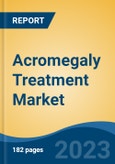Speak directly to the analyst to clarify any post sales queries you may have.
10% Free customizationThis report comes with 10% free customization, enabling you to add data that meets your specific business needs.
Growing awareness of the disease and the need for timely diagnosis and treatment are fueling market demand. One of the most promising developments includes the emergence of paltusotine, a novel oral therapy by Crinetics Pharmaceuticals. This first-of-its-kind, once-daily, nonpeptide alternative to injectable treatments is currently under FDA review, representing a major step forward in enhancing patient convenience and adherence. With increasing investments in innovation and treatment accessibility, the global market for acromegaly therapies continues to gain traction.
Key Market Drivers
Advancements in Therapeutic Approaches
The evolution of treatment strategies for acromegaly is significantly contributing to market growth. Historically, management of the disorder relied heavily on surgical intervention and radiation therapy to address pituitary tumors. However, recent pharmaceutical advancements have expanded the range of treatment options, particularly for patients unsuitable for surgery. Notably, the introduction of somatostatin analogs, dopamine agonists, and growth hormone receptor antagonists has improved disease control and quality of life. These therapies target different pathways in GH production and action - somatostatin analogs suppress GH secretion, while receptor antagonists block GH activity. The emergence of oral therapies further enhances treatment adherence and patient outcomes, making advanced medical interventions a critical driver of market expansion.Key Market Challenges
Late Diagnosis and Underdiagnosis
One of the critical challenges in the acromegaly treatment market is the late or underdiagnosis of the condition. Due to its slow and subtle onset, symptoms such as fatigue, joint pain, and physical changes often go unnoticed or are mistaken for aging or unrelated health issues. As a result, patients frequently delay seeking medical attention, and even when they do, healthcare providers may misattribute symptoms to more common conditions. This lack of awareness and diagnostic familiarity among clinicians often results in delayed detection, reducing treatment effectiveness and increasing complication risks. Given acromegaly’s rarity, many physicians have limited exposure to its clinical presentation, further contributing to underrecognition and delayed care.Key Market Trends
Early Diagnosis and Screening Programs
The rise of early diagnosis and screening programs is a notable trend shaping the Global Acromegaly Treatment Market. With improved awareness among both medical professionals and the public, targeted screening efforts have emerged to detect acromegaly at earlier stages. These initiatives often focus on high-risk individuals or those presenting hallmark symptoms such as acral changes, cardiovascular issues, and facial enlargement. Early diagnosis enables quicker therapeutic intervention, which can prevent the progression of complications and improve chances of biochemical remission. By enabling timely and effective treatment, these programs are not only enhancing patient outcomes but also contributing to market growth through increased diagnosis rates and therapy uptake.Key Players Profiled in this Acromegaly Treatment Market Report
- Recordati Rare Diseases
- Pfizer Inc.
- Validus Pharmaceuticals LLC
- Ipsen Pharma
- Crinetics Pharmaceuticals, Inc.
- Amryt Pharma plc
- Debiopharm
- ADVANZ PHARMA
- Novartis Pharmaceuticals Corporation
- Amolyt Pharma
Report Scope:
In this report, the Global Acromegaly Treatment Market has been segmented into the following categories, in addition to the industry trends which have also been detailed below:Acromegaly Treatment Market, by Drugs:
- Somatostatin Analogs
- Growth Hormone Receptor Antagonists
- Dopamine Agonists
- Combination Therapy
Acromegaly Treatment Market, by Route of Administration:
- Oral
- Subcutaneous
- Others
Acromegaly Treatment Market, by Distribution Channel:
- Hospital Pharmacies
- Retail Pharmacies
- Online Pharmacies
Acromegaly Treatment Market, by Region:
- North America
- United States
- Canada
- Mexico
- Europe
- France
- United Kingdom
- Italy
- Germany
- Spain
- Asia-Pacific
- China
- India
- Japan
- Australia
- South Korea
- South America
- Brazil
- Argentina
- Colombia
- Middle East & Africa
- South Africa
- Saudi Arabia
- UAE
- Egypt
Competitive Landscape
Company Profiles: Detailed analysis of the major companies present in the Global Acromegaly Treatment Market.Available Customizations:
With the given market data, the publisher offers customizations according to a company's specific needs. The following customization options are available for the report.Company Information
- Detailed analysis and profiling of additional market players (up to five).
This product will be delivered within 1-3 business days.
Table of Contents
Companies Mentioned
The leading companies profiled in this Acromegaly Treatment market report include:- Recordati Rare Diseases
- Pfizer Inc.
- Validus Pharmaceuticals LLC
- Ipsen Pharma
- Crinetics Pharmaceuticals, Inc.
- Amryt Pharma plc
- Debiopharm
- ADVANZ PHARMA
- Novartis Pharmaceuticals Corporation
- Amolyt Pharma
Table Information
| Report Attribute | Details |
|---|---|
| No. of Pages | 182 |
| Published | May 2025 |
| Forecast Period | 2024 - 2030 |
| Estimated Market Value ( USD | $ 1.44 Billion |
| Forecasted Market Value ( USD | $ 2.11 Billion |
| Compound Annual Growth Rate | 6.7% |
| Regions Covered | Global |
| No. of Companies Mentioned | 11 |









